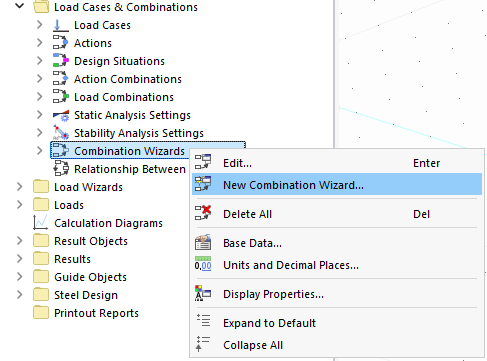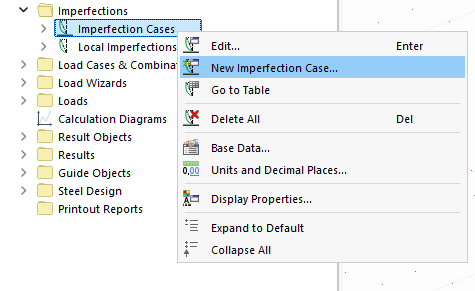This section describes how to perform a second-order analysis, taking into account the global imperfections. According to Eurocode 3, this is particularly necessary if the critical load factor calculated in the stability analysis is less than 10. In the example of the stair tower, the initial sway imperfections are to be applied to the columns as imperfections.
The specifications are again set in the combination wizard. To do this, create a new combination wizard, for example, using the "Data Navigator", where the imperfection cases are activated and the second-order analysis is selected in the static analysis settings.
It is then necessary to assign this combination wizard to the design situation in the "Load Cases and Combinations" dialog box.
Creating Imperfection Case
Just like the loads, the imperfections are sorted in cases. You can create a new imperfection case in the "Data navigator".
Enter a name for the imperfection case, such as "Imperfections in +Y" in our example, and click "OK" to confirm your entry.
Member Set Imperfections
Now, you can use the
![]() button to create a new member set imperfection for this imperfection case. The member set imperfections, as in the case of member imperfections, are taken into account in the calculation using equivalent loads.
button to create a new member set imperfection for this imperfection case. The member set imperfections, as in the case of member imperfections, are taken into account in the calculation using equivalent loads.
In the "Categories" section, you can first specify which imperfection you want to apply and how it should be aligned. In our example, the initial sway imperfection refers to the global coordinate system and is calculated according to Eurocode 3. Depending on these specifications, further input options appear in the "Parameters" section.
When generating the imperfection according to Eurocode 3, it is necessary, among other things, to specify the height of the structure and the number of columns in a row. If you do not know the height of the structure, you can simply select it via
![]() in the graphics by clicking on the top and bottom of the column, one after another.
in the graphics by clicking on the top and bottom of the column, one after another.
Finally, it is necessary to assign the imperfection to the member sets. In the webinar, all columns were grouped into member sets in advance. In the RFEM 6 Manual, you can find information on how to create a member set. As an alternative, you can create a member imperfection and assign it to a list of members. You can also find all explanations in the online manual.
Copying Imperfection Case
You can enter the initial sway imperfection in the +X direction in the same way. To do this, double-click the previously created imperfection case in the "Data navigator" and copy it via
![]() . In the associated member set imperfection, you only have to adjust the direction of the initial sway imperfection.
. In the associated member set imperfection, you only have to adjust the direction of the initial sway imperfection.






